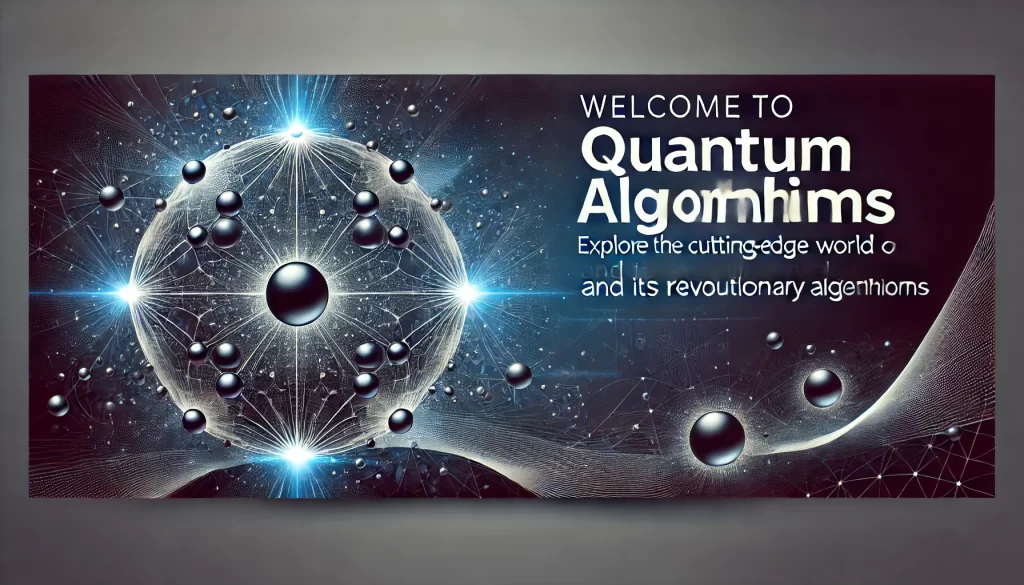
Quantum algorithms are computational procedures that leverage the principles of quantum mechanics to perform calculations. Unlike classical algorithms that use bits as the smallest unit of information, quantum algorithms use quantum bits or qubits, which can exist in multiple states simultaneously thanks to the phenomenon of superposition. This allows quantum algorithms to solve certain problems much more efficiently than classical algorithms.
Key Concepts in Quantum Computing
- Qubits: The basic unit of quantum information, analogous to classical bits. Qubits can be in a state |0⟩, |1⟩, or any quantum superposition of these states.
- Superposition: A fundamental principle of quantum mechanics where a quantum system can be in multiple states simultaneously.
- Entanglement: A quantum phenomenon where two or more qubits become interconnected, such that the state of one qubit instantaneously affects the state of the other, regardless of the distance separating them.
- Quantum Gates: Operations that modify the state of qubits, similar to logic gates in classical computing. Quantum gates are reversible and are represented by unitary matrices.
- Quantum Circuits: A sequence of quantum gates that perform a computation on qubits. Quantum circuits are the building blocks of quantum algorithms.
Importance of Quantum Algorithms

Quantum algorithms are crucial because they can provide exponential speedups for certain computational problems. They are particularly useful for problems in cryptography, optimization, and simulation of quantum systems, where classical algorithms are inefficient.
Key Quantum Algorithms
1. Shor’s Algorithm
Problem Solved: Integer factorization, which is the basis for the security of many encryption schemes like RSA.
Significance: Shor’s algorithm can factorize large integers exponentially faster than the best-known classical algorithms, potentially breaking widely used cryptographic protocols.
How It Works:
- Shor’s algorithm uses quantum Fourier transform (QFT) to find the period of a function, which is then used to deduce the factors of a given integer.
- The algorithm is probabilistic, meaning it gives the correct answer with high probability and can be repeated to increase confidence.
Steps:
- Choose a random number ( a < N ) (where ( N ) is the number to factor).
- Check if ( a ) is a nontrivial factor of ( N ) (e.g., using the Euclidean algorithm).
- Use a quantum computer to find the period ( r ) of the function ( f(x) = a^x \mod N ).
- If ( r ) is even and ( a^{r/2} \neq -1 \mod N ), then the factors of ( N ) are given by ( \gcd(a^{r/2} \pm 1, N) ).
2. Grover’s Algorithm
Problem Solved: Unstructured search problems, such as finding an entry in an unsorted database.
Significance: Grover’s algorithm provides a quadratic speedup over classical algorithms, which require checking each entry one by one.
How It Works:
- Grover’s algorithm uses amplitude amplification to increase the probability of finding the correct solution.
- It involves iteratively applying Grover’s operator, which consists of an oracle and a diffusion operator.
Steps:
- Initialize the system in a superposition of all possible states.
- Apply the oracle function to mark the correct solution.
- Apply the diffusion operator to amplify the probability of the marked state.
- Repeat steps 2 and 3 approximately ( \sqrt{N} ) times, where ( N ) is the number of possible solutions.
- Measure the system to obtain the solution with high probability.
3. Quantum Fourier Transform (QFT)
Problem Solved: Efficiently computes the discrete Fourier transform of quantum states.
Significance: QFT is a key component in many quantum algorithms, including Shor’s algorithm.
How It Works:
- QFT transforms a quantum state into its frequency domain representation.
- It is similar to the classical fast Fourier transform (FFT) but operates on quantum states.
Steps:
- Apply a series of Hadamard and controlled phase shift gates to the qubits.
- The transformation requires ( O(n^2) ) operations for ( n ) qubits, which is exponentially faster than the classical FFT.
4. Deutsch-Josza Algorithm
Problem Solved: Determines whether a function is constant or balanced.
Significance: This algorithm was one of the first to demonstrate quantum advantage over classical algorithms.
How It Works:
- The algorithm uses superposition and interference to evaluate a function in a single query.
Steps:
- Prepare a quantum system with qubits in a superposition of all possible inputs.
- Apply the oracle to determine the function’s output for each input simultaneously.
- Use interference to distinguish between constant and balanced functions with a single query.
Building Quantum Algorithms

To design a quantum algorithm, follow these steps:-
- Define the Problem: Identify the computational problem you want to solve and determine if a quantum algorithm could offer an advantage.
- Choose a Representation: Decide how to represent the problem using qubits and quantum states.
- Design Quantum Circuits: Construct quantum circuits using quantum gates that manipulate the qubits to solve the problem.
- Analyze Complexity: Evaluate the algorithm’s complexity and compare it with classical alternatives to ensure quantum advantage.
- Simulate and Test: Use quantum simulators or actual quantum computers to test the algorithm and verify its correctness.
Quantum Algorithm Applications
Quantum algorithms have potential applications in various fields:-
- Cryptography: Breaking classical encryption schemes and developing quantum-resistant protocols.
- Optimization: Solving complex optimization problems in logistics, finance, and artificial intelligence.
- Simulation: Simulating quantum systems for drug discovery, material science, and fundamental physics research.
- Machine Learning: Enhancing machine learning models with quantum computing techniques.
Challenges and Future Directions

While quantum algorithms offer significant potential, there are challenges to overcome:-
- Scalability: Building scalable quantum computers with enough qubits and low error rates.
- Error Correction: Developing efficient quantum error correction techniques to mitigate decoherence and noise.
- Algorithm Development: Creating new quantum algorithms for a broader range of problems.
The future of quantum computing is promising, with ongoing research and advancements bringing us closer to realizing the full potential of quantum algorithms.
Thanks,